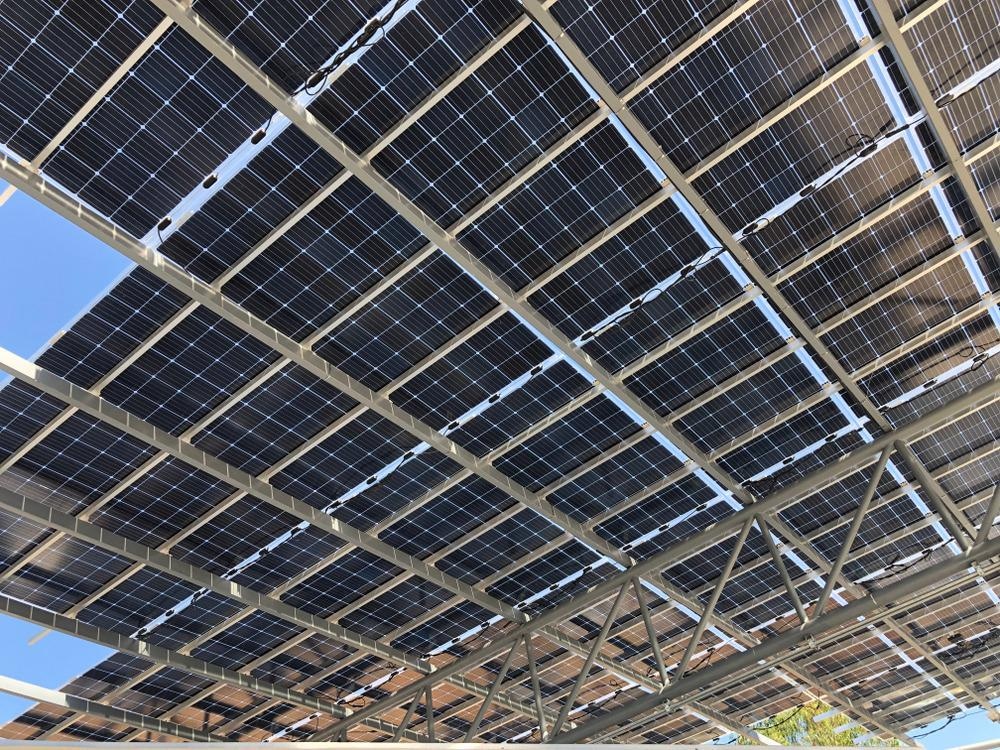
Image Credit: Jak76/Shutterstock.com
Researchers in Australia have developed an algorithm to calculate the exact size and density of quantum dots necessary to create record efficiency in solar panels.
The researchers from Monash University in Australia, a part of the ARC Centre of Excellence in Exciton Science, believe that if their results were to be fully realized, solar cells could operate at efficiencies that greatly exceed current records and at orders of state-of-the-art magnitude.
Light Fusion and the PbS Quantum Dot
Quantum dot technology has long been investigated for its potential to uncap the efficiency-limits of solar cells, typically constrained by the Shockley-Queisser efficiency limit at approximately 33%.
Quantum dots can be used in light fusion (or photochemical upconversion), where ‘wasted’ light is upconverted into current for a solar cell. The light fusion process uses a light ‘sensitizer’ and light ‘emitter’ to convert photons of energy lower than a solar cell’s bandgap, which would otherwise not be converted into current, into higher energy photons. This increases the amount of light that the cell can use productively, hence its efficiency.
Existing research into the application of quantum dot technology to photovoltaics has shown that quantum dot sensitizers outperform organic sensitizers, which are traditionally used in light fusion. This is due to the high photo-stability and absorption properties of quantum dots: specifically, their very large absorption co-efficient and an absorption cross-section that is ‘tunable’ across a wide range of energies.
In choosing their sensitizer, the Monash researchers decided to work with quantum dots from the IV-VI group of elements as they possess the necessary energy levels required, can be synthesized on a large scale and can be tuned to absorb light below the bandgap of the most frequently used solar cell material: silicon.
From the IV-VI quantum dots' family, lead sulfide (PbS) was chosen for investigation due to its elemental abundance and as it is already commonly synthesized.
Optimizing the Dot – From Sun to Cell
In the final analysis, the Monash researchers found that PbS quantum dot sensitizers of approximately 2.2 nm in quantum radius produced optimal results in silicon solar cells and a figure of merit that significantly exceeded the current record.
The fact that these results were produced in a silicon environment is a significant bonus. Existing experiments use organic sensitizers that are not compatible with silicon solar cells. This is a considerable commercial limitation, given that silicon solar cells are the predominant photovoltaic technology.
A wide range of radii and concentrations showed potential for order of magnitude improvements if fully realized, even with the requirement of silicon-compatibility.
The findings also provide a more sophisticated understanding of how the size of a quantum dot relates to the range of the solar spectrum captured by a solar cell and its effect on energy efficiency.
A rudimentary interpretation of the physical laws applying to quantum dots would suggest that a larger quantum dot would capture more of the solar spectrum and be more effective. Though the Monash researchers say this model is “conceptually correct”, they discovered that it must be refined with four key details:
- Due to the water in the Earth’s atmosphere, the near-infrared spectrum of sunlight at the Earth’s surface has a complicated structure, and the quantum dots color must be tuned according to the peaks of sunlight.
- Very large quantum dots suffer from low colloidal stability and are forced to sacrifice concentration for increased size as they must not overlap.
- Quantum dots are never transparent at energies above the first excited state.
- Energy must be exothermically transferred from the sensitizer to the emitter molecule.
Commercial Prospects and Next Steps
PbS quantum dots are compatible in principle with all photovoltaics, which have a bandgap larger than bulk PbS. As the light fusion process can be synthesized in a liquid form, it also has the potential to be cheap enough that even small figures of merit may be economically effective.
To be realized as a commercial device, the PbS sensitizer will need a corresponding light emitter that can provide efficient energy transfer from sensitizer to emitter and stable energy storage, efficient fluorescence, and several other properties. According to the researchers, all of these properties have been demonstrated separately in experiments but are yet to be shown simultaneously.
Co-author of the paper, Dr Laszlo Frazer, highlighted the importance of improving our understanding of every element of the solar energy chain, from the sun and atmosphere to the solar cell and the quantum dot itself, to maximize the efficiency of solar cells. Fellow co-author Benedicta Sherrie hoped the research would “eventually allow society to rely more on photovoltaic solar energy that is not only efficient, but also affordable.”
The researchers’ algorithm is free to access and can simulate scenarios with varying illumination, absorption, and emission spectra.
References and Further Reading
ARC Centre of Excellence in Exciton Science. Goldilocks and the three quantum dots: This one’s just right for peak solar panel performance. Available at: https://excitonscience.com/news/goldilocks-and-three-quantum-dots-ones-just-right-peak-solar-panel-performance (Accessed on 21 January 2021).
Benedicta Sherrie, Alison M. Funston, Laszlo Frazer (2020) Optimal quantum dot size for photovoltaics with fusion. Nanoscale. https://doi.org/10.1039/D0NR07061K
Octavi E. Semonin, Joseph M. Luther, Matthew C. Beard (2012) Quantum dots for next-generation photovoltaics. Materials Today. https://doi.org/10.1016/S1369-7021(12)70220-1
Disclaimer: The views expressed here are those of the author expressed in their private capacity and do not necessarily represent the views of AZoM.com Limited T/A AZoNetwork the owner and operator of this website. This disclaimer forms part of the Terms and conditions of use of this website.